Kpe160 - Study guides, Class notes & Summaries
Looking for the best study guides, study notes and summaries about Kpe160? On this page you'll find 26 study documents about Kpe160.
Page 2 out of 26 results
Sort by
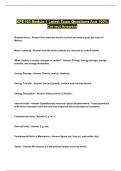
-
KPE160 Module 1 Latest Exam Questions And 100% Correct Answers
- Exam (elaborations) • 12 pages • 2024
- Available in package deal
-
- $11.99
- + learn more
KPE160 Module 1 Latest Exam Questions And 100% Correct Answers...
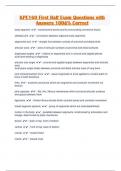
-
KPE160 First Half Exam Questions with Answers 100% Correct
- Exam (elaborations) • 8 pages • 2024
-
- $13.89
- + learn more
KPE160 First Half Exam Questions with Answers 100% Correct KPE160 First Half Exam Questions with Answers 100% Correct KPE160 First Half Exam Questions with Answers 100% Correct KPE160 First Half Exam Questions with Answers 100% Correct KPE160 First Half Exam Questions with Answers 100% Correct KPE160 First Half Exam Questions with Answers 100% Correct KPE160 First Half Exam Questions with Answers 100% Correct KPE160 First Half Exam Questions with Answers 100% Correct KPE160 First Half Exam Quest...
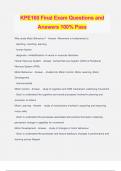
-
KPE160 Final Exam Questions and Answers 100% Pass
- Exam (elaborations) • 34 pages • 2024
- Available in package deal
-
- $13.49
- + learn more
KPE160 Final Exam Questions and Answers 100% Pass Why study Motor Behaviour? - Answer- Movement is fundamental to: - teaching, coaching, learning - human factors - diagnosis / rehabilitization of neural or muscular disorders Human Nervous System - Answer- Central Nervous System (CNS) & Peripheral Nervous System (PNS) Motor Behaviour - Answer- - divided into Motor Control, Motor Learning, Motor Development - interconnected Motor Control - Answer- - study of cognitive and CNS mechanism ...
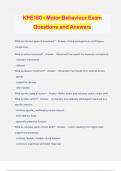
-
KPE160 - Motor Behaviour Exam Questions and Answers
- Exam (elaborations) • 41 pages • 2024
- Available in package deal
-
- $13.49
- + learn more
KPE160 - Motor Behaviour Exam Questions and Answers What are the two types of movement? - Answer- Active (endogenous) and Passive (exogenous) What is active movement? - Answer- - Movement that results fro muscular contractions - voluntary movements - reflexes What is passive movement? - Answer- - Movement that results from external forces - gravity - supportive devices - other bodies What are the types of action? - Answer- Reflex action and voluntary action (motor skill) What is refl...
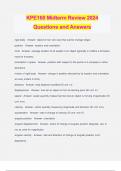
-
KPE160 Midterm Review 2024 Questions and Answers
- Exam (elaborations) • 31 pages • 2024
- Available in package deal
-
- $13.49
- + learn more
KPE160 Midterm Review 2024 Questions and Answers rigid body - Answer- object of non-zero size that cannot change shape position - Answer- location and orientation CoG - Answer- average location of all weight of an object (typically in midline a bit below navel of humans) orientation in space - Answer- position with respect to the points of a compass or other directions motion of rigid body - Answer- change in position denoted by its location and orientation at every instant in time) di...
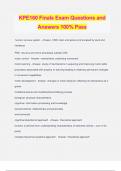
-
KPE160 Finals Exam Questions and Answers 100% Pass
- Exam (elaborations) • 22 pages • 2024
- Available in package deal
-
- $12.49
- + learn more
KPE160 Finals Exam Questions and Answers 100% Pass human nervous system - Answer- CNS: brain and spinal cord encased by skull and vertebrae PNS: neurons and nerve processes outside CNS motor control - Answer- mechanisms underlying movement motor learning - Answer- study of mechanisms in acquiring and improving motor skills processes associated with practice or learning leading to relatively permanent changes in movement capabilities motor development - Answer- changes in motor behavior ...
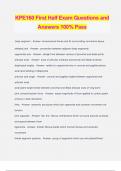
-
KPE160 First Half Exam Questions and Answers 100% Pass
- Exam (elaborations) • 11 pages • 2024
- Available in package deal
-
- $12.49
- + learn more
KPE160 First Half Exam Questions and Answers 100% Pass body segment - Answer- bone/several bones and its surrounding connective tissue skeletal joint - Answer- connection between adjacent body segments segmental axis - Answer- straight line between centres of proximal and distal joints articular axes - Answer- axes of articular surfaces at proximal and distal surfaces diaphyseal angles - Answer- relative to segmental axis in coronal and sagittal planes axial lane twisting of diaphyses ar...

-
KPE160 midterm Exam Questions and Answers 100% Pass
- Exam (elaborations) • 10 pages • 2024
- Available in package deal
-
- $7.99
- + learn more
KPE160 midterm Exam Questions and Answers 100% Pass Space - Answer- distance is the linear measure of space (m,km,cm) Space and planar angle - Answer- a figure made by two intersecting lines or planes, an angular measure of space (radians, degrees, revolutions) Time - Answer- monotonically increasing quantity (s) Matter - Answer- Anything that has mass and takes up space Mass(m) - Answer- how much matter is in a material body (kg) Volume(V) - Answer- How much space an object takes up (L)...
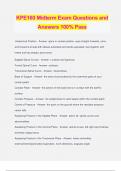
-
KPE160 Midterm Exam Questions and Answers 100% Pass
- Exam (elaborations) • 10 pages • 2024
- Available in package deal
-
- $12.49
- + learn more
KPE160 Midterm Exam Questions and Answers 100% Pass Anatomical Position - Answer- spine in neutral position, eyes straight forwards, arms and forearms at side with elbows extended and hands supinated, feet together with knees and hip straight, penis erect Sagittal Spinal Curves - Answer- Lordosis and kyphosis Frontal Spinal Curve - Answer- scoliosis Transverse Spinal Curve - Answer- rotoscoliosis Base of Support - Answer- the area circumscribed by the outermost parts of your contact pat...

-
KPE160 DOUG PREP QUESTIONS AND ANSWERS 100% PASS
- Exam (elaborations) • 17 pages • 2024
- Available in package deal
-
- $12.49
- + learn more
KPE160 DOUG PREP QUESTIONS AND ANSWERS 100% PASS Centre of Gravity vs Centre of Mass - Answer- centre of mass depends on the distribution of mass (not gravitational field) and it doesn't change even if you move or orient yourself differently. Centre of gravity is a unique point which weight is balanced, it can change based on orientation and also takes into account mass distribution. Is it harder to lift or lower a mass? Which feels harder and why? - Answer- It takes the same amount of f...

How did he do that? By selling his study resources on Stuvia. Try it yourself! Discover all about earning on Stuvia


